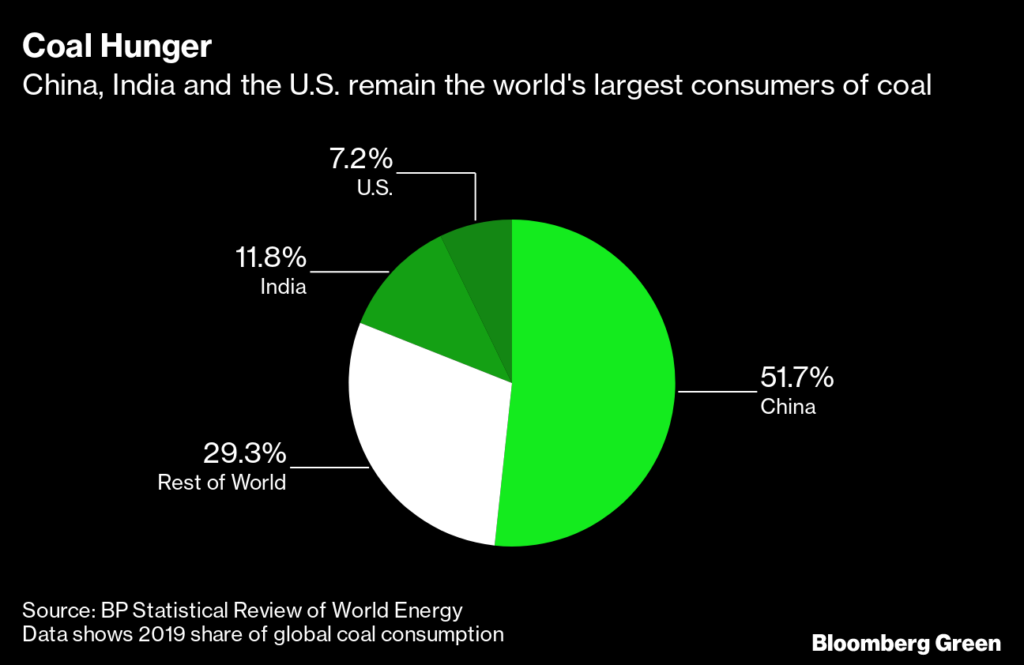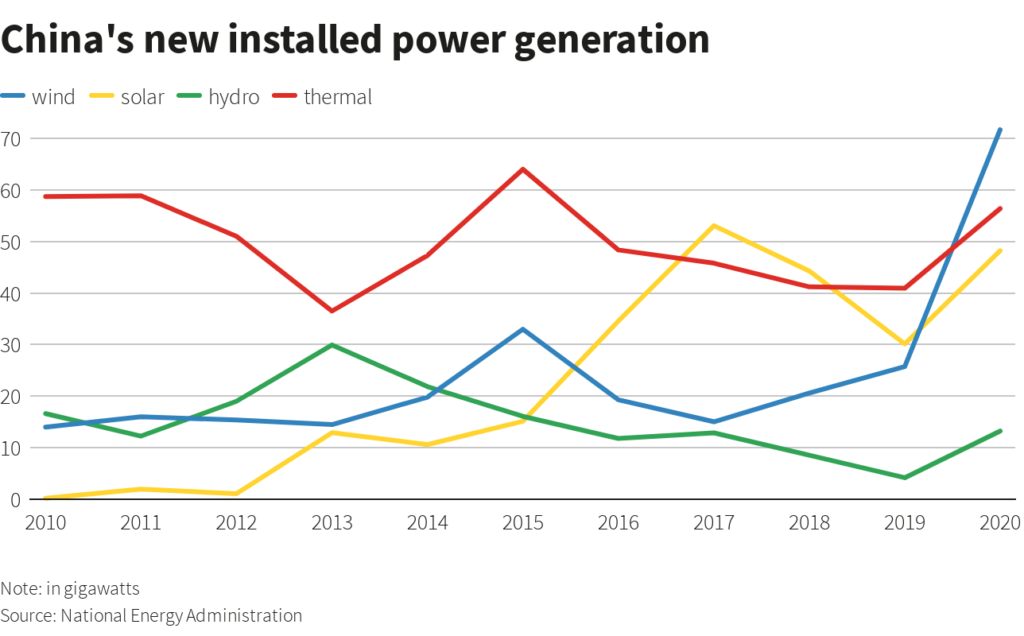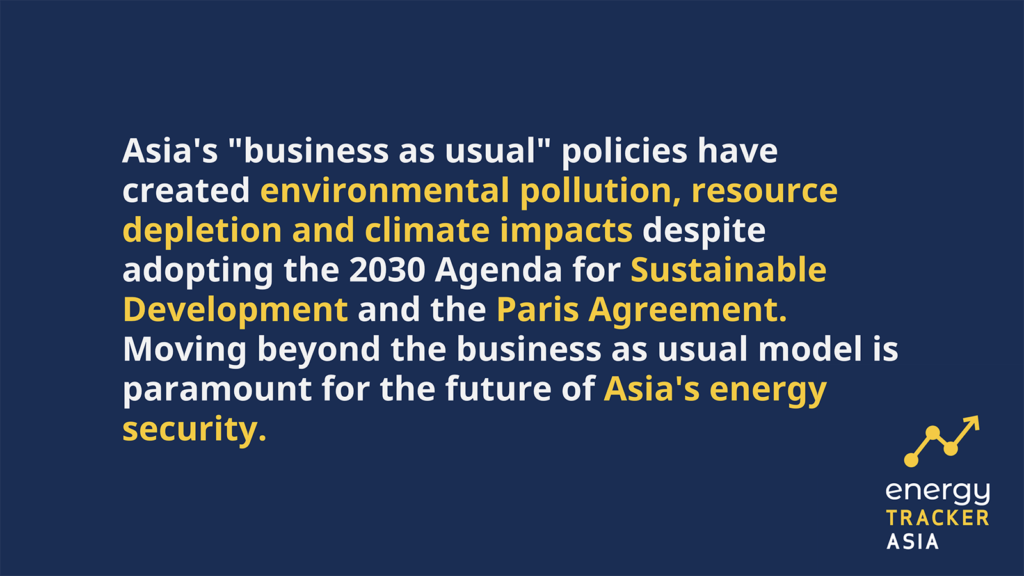Energy Transition in Asia: Balancing Two Sides
Source: Chatham House
14 February 2022 – by Eric Koons
Asia’s energy transition hinges on successfully balancing growing energy demand and developing a resilient grid. The region holds over half of the world’s population and accounts for a quarter of the global economy. Additionally, Asia is home to some of the fastest-growing per capita GDPs globally. As a result, per capita energy demand in emerging markets of Asia has increased 18% over the last decade, and there are no signs of a slowdown. This rise demands more clean energy solutions such as solar energy and energy efficiency to fight climate change.

Fossil Fuels Challenge and Renewable Energy Solutions in Asia
At the COP26 climate conference, large energy-consuming countries and emerging economies—namely India and China—negotiated for a “phasing down” on coal instead of phasing out. By all accounts, this will be the defining challenge for Asia over the next decade by balancing energy demand and switching to renewable energy.
More Share of Renewables in the Energy Mix – Needed
Asia’s “business as usual” policies have created environmental pollution, resource depletion and climate impacts. Consequently, many urban and rural Asian communities already feel the effects of this unsustainable development. Despite adopting the 2030 Agenda for Sustainable Development and the Paris Agreement, the continent still has a long way to go. Moving beyond the business as usual model is paramount for Asia’s future, meaning that a switch to renewables will both maintain its energy security and stabilise its energy markets.
What is the Main Source of Energy in Asia?
The main source of energy in Asia is coal While European and American markets are starting to shut down their coal-fired power plants, the dirty fuel remains a major player in global energy systems—especially in Asia. This is primarily due to growing energy demands, with China having an enormous role.
China is the world’s largest consumer of coal, accounting for over 50% of all coal burnt globally. It is also the world’s largest coal producer. Yet, China’s dependence on coal has helped it become the world’s second-largest economy while subsequently pulling nearly a billion people out of poverty.

Why is Energy Demand Increasing in Asia?
The rapidly increasing energy demand in Asia is primarily due to high population growth rates and a growing middle class. This increasing economic stability and wealth of the middle class have fuelled urbanisation and demands for modernisation.
Furthermore, as China, India, and other economic powerhouses develop further, energy demand is bound to soar. If all things remain equal, this growth path will inevitably lead to more fossil fuel use in public and private sectors. Ultimately, this will slow Asia’s energy transition.
However, alternative paths are possible. If Asian countries develop effective energy transition strategies, they can easily meet growing demand and reduce emissions simultaneously. While this requires concrete national commitments and regional climate goals, it is realistic.
Which Asian Country Has Made the Most Successful Energy Transition?
Generally speaking, Asia is slowly switching to renewables. Yet, a few countries in the region are leading the way.
According to the 2021 Energy Transition Index (ETI), Singapore is the highest-ranking Asian country and ranks 18 globally. The ETI benchmarks countries based on their readiness for an energy transition and their current progress. So far, Singapore has made significant progress in building an inclusive, sustainable, affordable and secure energy system.
While Singapore has limited renewable resources, they are pursuing an alternative strategy—importing low carbon energy. This has proved fruitful for the strength of its energy system and is playing a vital role in seeing the city-state successfully transition to clean energy. Singapore’s energy transition comes amidst a history of heavy fossil fuel reliance, yet the government is now consistently pushing policy toward a renewable energy-based future.
The city-state and economic hub is a shining example of energy transition in Asia.
What Country in Asia Produces the Most Renewable Energy?
China is the world’s largest renewable energy producer, despite being the largest consumer and producer of fossil fuels. In China’s most recent and 14th five-year economic plan, the country prioritised innovation and technology. This also had a specific focus on renewable energy.

Furthermore, according to the International Energy Agency (IEA), between 2019 and 2024, China is expected to account for over 35% of global wind and solar capacity expansion. Enhanced solar PV, onshore wind technology, improved system integration and lower curtailment rates have pushed and created this change.
Despite the seemingly good news, China is still dependent on powering immediate growth with fossil fuels like coal and gas. Due to this, the economic giant can’t be considered an ideal role model for the energy transition in Asia. However, this does change if China focuses on and prioritises clean and renewable energy sources to fuel its growth.
Asia’s Energy Transition – The Future of Renewable Energy in Asia
While Asia dominates the world’s fossil fuel consumption and production, there are encouraging signs. First, China has the largest renewable energy capacity globally and is backing its growth with policy. Secondly, Singapore proves that alternative strategies are available for an energy transition regardless of available resources.
Unfortunately, this is not enough, and fossil fuel consumption rates still need to fall and ultimately cease to be used. Even though fossil fuels have historically fuelled Asia’s impressive economic growth, they will anchor the region down if nothing changes. This will affect economies, growth rates and social development across the region. Continuous, prosperous and sustainable economic development is simply not possible without a just energy transition in Asia.
Go further with Energy Transition
This article is part of our comprehensive guide on energy transition.
In the following articles, we will discuss more related topics, such as the energy transition strategy.

by Eric Koons
Eric is a passionate environmental advocate that believes renewable energy is a key piece in meeting the world’s growing energy demands. He received an environmental science degree from the University of California and has worked to promote environmentally and socially sustainable practices since. Eric’s expertise extends across the environmental field, yet he maintains a strong focus on renewable energy. His work has been featured by leading environmental organizations, such as World Resources Institute and Hitachi ABB Power Grids.
Read more


